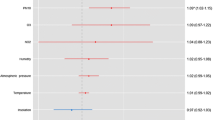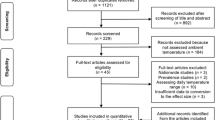Abstract
We analyzed the relationship between the incidence of spontaneous intracerebral hemorrhage (ICH) and various meteorological data (daily atmospheric air pressure, air temperature, precipitation, humidity, presence of typhoons, occurrence of the rainy season, wind velocity, and wind direction) for patients at Teraoka Memorial Hospital in Shin-ichi Town, Japan, from January 1, 2001 to December 31, 2003. All data were analyzed by contingency table analysis and multivariate regression analysis. From January 1, 2002 to December 31, 2003, we identified high-risk ICH days as those days for which the preceding 3 days mean recorded air pressure of 1,015 hPa or more and then conducted a statistical comparison of the incidence of ICH on high-risk ICH days with that on the other days. Our subjects were 164 patients with ICH. The relative risk of high-risk ICH days is 1.46 (Fisher’s exact test, p = 0.04). Mann–Whitney’s U-tests indicate ICH tends to occur on days with lower maximum air temperature. Multivariate logistic regression analysis revealed that 3 incidences influence the occurrence of intracerebral hemorrhage (p < 0.01 each): (1) days associated with 4-day periods of mean air pressure in excess of 1,015 hPa; (2) days during which a typhoon was approaching; and (3) days with west or southwest wind . Detailed examination of meteorological data indicates a relationship with the incident rate of ICH.
Similar content being viewed by others
References
Azevedo E, Ribeiro JA, Lopes F, Martins R, Barros H (1995) Cold: a risk factor for stroke? J Neurol 242(4):217–221
Biller JJM, Bruno A, Adams HP Jr, Banwart K (1988) Seasonal variation of stroke-does it exist? Neuroepidemiology 7(2):89–98
Brennan PJ, Greenberg G, Miall WE, Thompson SG (1982) Seasonal variation in arterial blood pressure. Br Med J 285:919–923
Bull GM, Brozovic M, Chakrabarti R, Meade TW, Morton J, North WRS, Stirling Y (1979) Relationship of air temperature to various chemical, haematological, and haemostatic variables. J Clin Pathol 32:16–20
Capon A, Demeurisse G, Zheng L (1992) Seasonal variation of cerebral hemorrhage in 236 consecutive cases in Brussels. Stroke 23(1):24–27
Chen ZY, Chang SF, Su CL (1995) Weather and stroke in a subtropical area: Ilan, Taiwan. Stroke 26(4):569–572
Danet S, Richard F, Montaye M, Beauchant S, Lemaire B, Graux C, Cottel D, Marecaux N, Amouyel P (1999) Unhealthy effects of atmospheric temperature and pressure on the occurrence of myocardial infarction and coronary deaths. A 10-year survey: the Lille-World Health Organization MONICA project (Monitoring trends and determinants in cardiovascular disease). Circulation 100(1):E1–E7
Gallerani M, Trappella G, Manfredini R, Pasin M, Napolitano M, Migliore A (1994) Acute intracerebral haemorrhage: circadian and circannual patterns of onset. Acta Neurol Scand 89(4):280–286
Gill JS, Davies P, Gill SK, Beevers DG (1988) Wind-chill and the seasonal variation of cerebrovascular disease. J Clin Epidemiol 41(3):225–230
Hannan MA, Rahman MM, Haque A, Ahmed HU (2001) Stroke: seasonal variation and association with hypertension. Bangladesh Med Res Counc Bull 27(2):69–78
Inagawa T, Takechi A, Yahara K, Saito J, Moritake K, Kobayashi S, Fujii Y, Sugimura C (2000) Primary intracerebral hemorrhage and aneurysmal subarachnoid hemorrhage in Izumo City, Japan. Part I: incidence and seasonal and diurnal variations. J Neurosurg 93(6):958–966
Jakovljevic D, Salomaa V, Sivenius J, Tamminen M, Sarti C, Salmi K, Kaarsalo E, Narva V, Immonen-Raiha P, Torppa J, Tuomilehto J (1996) Seasonal variation in the occurrence of stroke in a Finnish adult population. The FINMONICA stroke register. Finnish monitoring trends and determinants in cardiovascular disease. Stroke 27(10):1774–1779
Keatings WR, Coleshaw SRK, Cotter F, Mattock M, Murphy M, Chelliah R (1984) Increased in platelet and red cell counts, blood viscosity, and arterial pressure during mild surface cooling: factors in mortality from coronary and cerebral thrombosis in winter. Br Med J 289:1045–1048
Khan FA, Engstrom G, Jerntorp I, Pessah-Rasmussen H, Janzon L (2005) Seasonal patterns of incidence and case fatality of stroke in Malmo, Sweden: the STROMA study. Neuroepidemiology 24(1–2):26–31
Nakaji S, Parodi S, Fontana V, Umeda T, Suzuki K, Sakamoto J, Fukuda S, Wada S, Sugawara K (2004) Seasonal changes in mortality rates from main causes of death in Japan (1970–1999). Eur J Epidemiol 19(10):905–913
Ohwaki K, Yano E, Murakami H, Nagashima H, Nakagomi T (2004) Meteorological factors and the onset of hypertensive intracerebral hemorrhage. Int J Biometeorol 49(2):86–90
Passero S, Reale F, Ciacci G, Zei E (2000) Differing temporal patterns of onset in subgroups of patients with intracerebral hemorrhage. Stroke 31(7):1538–1544
Ramirez-Lassepas M, Haus E, Lakatua DJ, Sackett L, Swoyer J (1980) Seasonal (circannual) periodicity of spontaneous intracerebral hemorrhage in Minnesota. Ann Neurol 8(5):539–541
Shinkawa A, Ueda K, Hasuo Y, Kiyohara Y, Fujishima M (1990) Seasonal variation in stroke incidence in Hisayama, Japan. Stroke 21(9):1262–1267
Suzuki K, Kutsuzawa T, Takita K, Ito M, Sakamoto T, Hirayama A, Ito T, Ishida T, Ooishi H, Kawakami K et al (1987) Clinico-epidemiologic study of stroke in Akita, Japan. Stroke 18(2):402–406
Tsementzis SA, Kennet RP, Hitchcock ER, Gill JS, Beevers DG (1991) Seasonal variation of cerebrovascular diseases. Acta Neurochir (Wien) 111(3–4):80–83
Wang H, Sekine M, Chen X, Kagamimori S (2002) A study of weekly and seasonal variation of stroke onset. Int J Biometeorol 47(1):13–20
Wang Y, Levi CR, Attia JR, D’Este CA, Spratt N, Fisher J (2003) Seasonal variation in stroke in the Hunter Region, Australia: a 5-year hospital-based study, 1995–2000. Stroke 34(5):1144–1150
Author information
Authors and Affiliations
Corresponding author
Rights and permissions
About this article
Cite this article
Nakaguchi, H., Matsuno, A. & Teraoka, A. Prediction of the incidence of spontaneous intracerebral hemorrhage from meteorological data. Int J Biometeorol 52, 323–329 (2008). https://doi.org/10.1007/s00484-007-0128-1
Received:
Revised:
Accepted:
Published:
Issue Date:
DOI: https://doi.org/10.1007/s00484-007-0128-1




